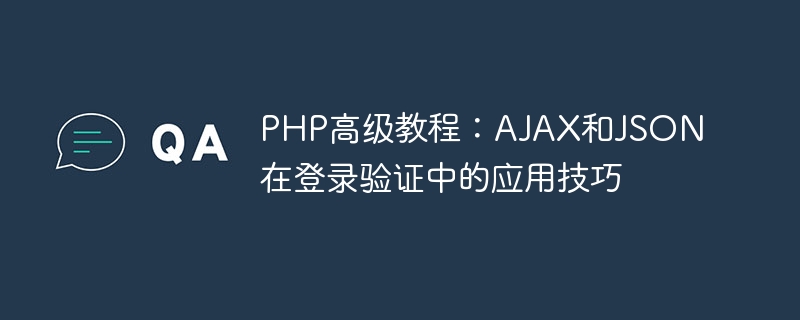Home >Backend Development >PHP Tutorial >PHP Advanced Tutorial: Application Skills of AJAX and JSON in Login Authentication
PHP Advanced Tutorial: Application Skills of AJAX and JSON in Login Authentication
- WBOYWBOYWBOYWBOYWBOYWBOYWBOYWBOYWBOYWBOYWBOYWBOYWBOriginal
- 2024-03-06 17:33:04733browse

PHP Advanced Tutorial: Application Skills of AJAX and JSON in Login Verification
In modern web applications, using AJAX and JSON for user login verification is a A common and effective method. AJAX (Asynchronous JavaScript and XML) allows sending and receiving data to the server without refreshing the entire page, while JSON (JavaScript Object Notation) is a lightweight data exchange format. Combining these two technologies can make the user experience smoother and more secure.
1. The basic principles of AJAX
AJAX implements data exchange with the server through the XMLHttpRequest object. When the user enters the username and password on the login page, JavaScript will send an asynchronous request to the server through AJAX. The server will verify the credentials entered by the user and return a response. Based on the response returned by the server, the JavaScript code can choose whether to allow the user to log in.
2. Advantages of JSON
Compared with traditional XML, JSON has higher performance and readability. JSON is a text format that can be easily parsed and generated across various programming languages. In login verification, the server can return the verification results to the client in JSON format, and the client processes the verification results by parsing the JSON data.
3. Practical Example
The following is a simple PHP sample code that demonstrates how to use AJAX and JSON for user login verification:
- HTML page code: login .html
<!DOCTYPE html>
<html>
<head>
<title>用户登录</title>
<script src="https://ajax.googleapis.com/ajax/libs/jquery/3.5.1/jquery.min.js"></script>
<script>
$(document).ready(function(){
$("#login-form").submit(function(event){
event.preventDefault();
var username = $("#username").val();
var password = $("#password").val();
$.ajax({
url: "login.php",
method: "POST",
data: {username: username, password: password},
dataType: "json",
success: function(response){
if(response.success){
alert("登录成功!");
} else {
alert(response.message);
}
}
});
});
});
</script>
</head>
<body>
<h2>用户登录</h2>
<form id="login-form">
<input type="text" id="username" placeholder="用户名">
<input type="password" id="password" placeholder="密码">
<button type="submit">登录</button>
</form>
</body>
</html>- PHP backend code: login.php
<?php
// 模拟用户验证
$username = $_POST['username'];
$password = $_POST['password'];
if($username === 'admin' && $password === '123456'){
$response = array('success' => true);
} else {
$response = array('success' => false, 'message' => '用户名或密码错误');
}
echo json_encode($response);
?>In the above example, after the user enters the username and password on the login.html page, JavaScript Send data to login.php via AJAX for verification. login.php returns a response in JSON format based on the verification result, and the client prompts accordingly based on the response.
In summary, by combining AJAX and JSON in user login verification, the user experience and security of web applications can be improved. I hope this article can help readers gain a deeper understanding of the AJAX and JSON technologies in PHP advanced tutorials and be able to use them flexibly in practice.
The above is the detailed content of PHP Advanced Tutorial: Application Skills of AJAX and JSON in Login Authentication. For more information, please follow other related articles on the PHP Chinese website!

